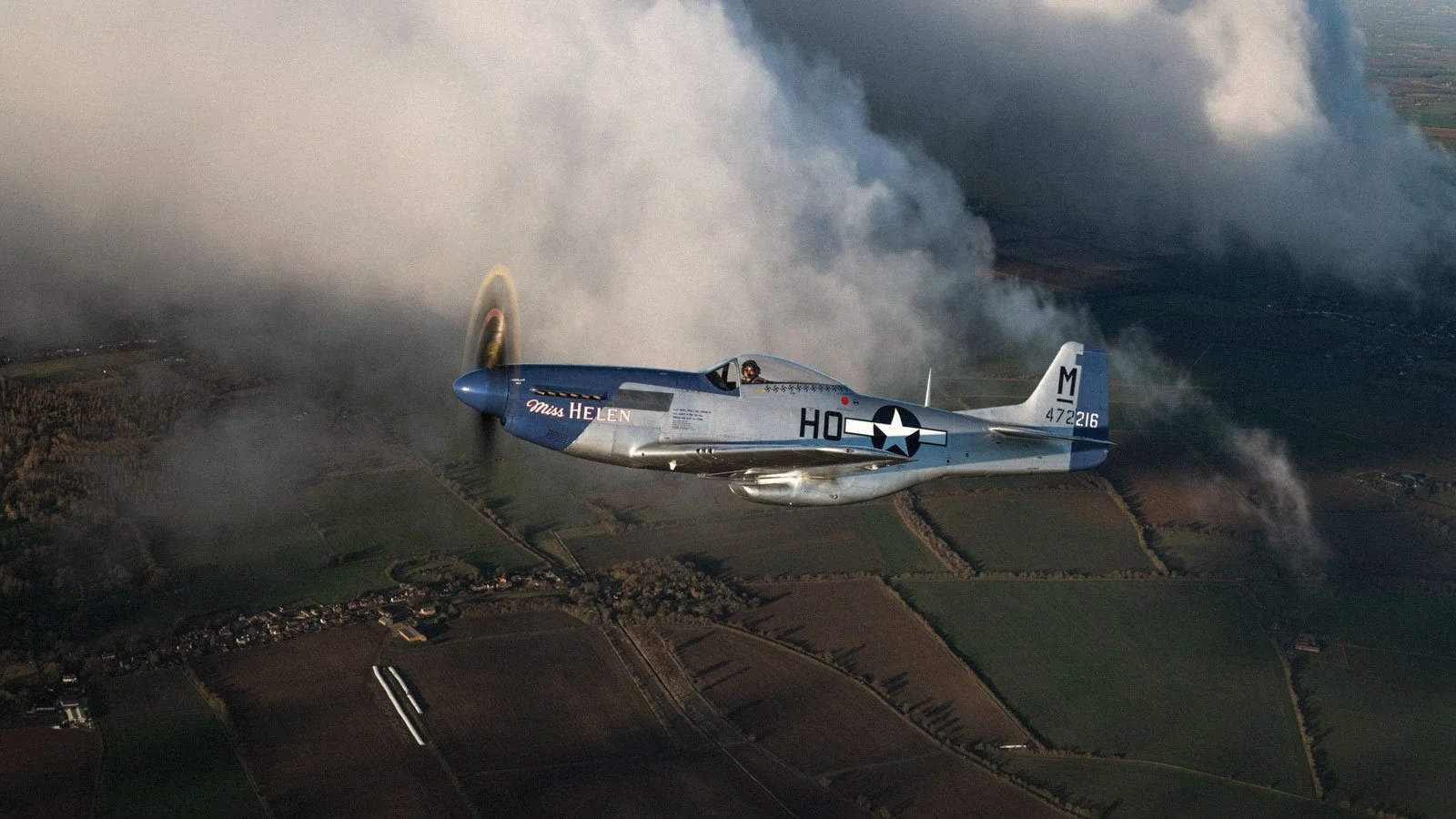
NORTH AMERICAN P-51 MUSTANG
MISS HELEN
P-51D Mustang ‘Miss Helen’ (G-BIXL) is one of the most historic surviving examples of this iconic long-range Second World War fighter. The type itself began life in 1940 when the British Purchasing Commission, keen to acquire more fighters for the Royal Air Force, asked North American Aviation whether they would consider building Curtiss P-40s under license. The North American team, headed by ‘Dutch’ Kindelberger, proposed going one better by designing and building a brand-new fighter with the same Allison engine to meet the RAF requirement. The prototype rolled out of the factory just 102 days after the order was placed. The airframe was considered ahead of its time with features like a laminar flow wing and extensive use of hydraulic systems, however the engine was considered a major limitation owing to its poor performance at the typical heights aerial combat was occurring at. In May 1942 a report by Rolls-Royce test pilot Ronnie Harker recommended fitting the Merlin 61 engine to improve performance as was fitted to Spitfires at the time. Flight trials both sides of the Atlantic showed a significant improvement and the legend was born.
This Mustang, 44-72216, was constructed at North American Aviation’s Inglewood, California plant in 1944. In April 1945 the airframe was delivered to the famous 352nd Fighter Group based at RAF Bodney in Norfolk, where it became the personal mount of Capt. Ray Littge – an accomplished fighter pilot with 10 ½ aerial victories already to his name including an Me262 jet. Littge quickly named the aircraft ‘Miss Helen’ in correspondence with his fiancée Helen Fischer. With the end of hostilities just weeks away, his time flying this Mustang was brief – however, on 17th April 1945, Littge used ‘Miss Helen’ in a strafing operation on Plattling airfield in Germany and, despite sustaining significant damage to the aircraft, managed to claim 6 ground victories and recover the P-51 to Bodney. Littge’s tour ended shortyly after and ‘Miss Helen’ became ‘Miss Nita’ upon becoming the mount of Capt. Russell Ross, who flew the aircraft until victory in Europe was declared. Following a period in storage, the Mustang was transferred to the Swedish Air Force, where it flew until sale to the Israeli Defence Force in 1953.
The role of the Mustang in Israeli service changed from frontline fighter to advanced trainer as more modern types were acquired. Eventually it was deemed surplus to requirements altogether and ‘Miss Helen,’ by now purely known as ’43’, was retired and became a child’s plaything. British warbird collector and racing driver Robs Lamplough acquired the P-51 in 1976, recovering it to the UK where a full restoration to flight commenced at Duxford led by Norman Chapman. In 1981 the aircraft was moved to North Weald, from where it made its first post-restoration flight 6 years later. The restored fuselage in particular was highly original owing to the fact it had been found to be virtually corrosion-free. In the summer of 1989, ‘Miss Helen’ became ‘Miss L’ and gained an olive drab scheme to become one of the Mustangs used for the filming of ‘Memphis Belle’ at Duxford. In 2001, the aircraft regained its ‘blue-nosed’ wartime colours which it has worn ever since.
‘Miss Helen’ has been a mainstay of the European airshow circuit since returning to the air. In 2014, Robs Lamplough sold the aeroplane to Robert Tyrrell who has been her custodian ever since. The aircraft is also operated by Aerial Collective, the Aircraft Restoration Company’s in-house warbird experience provider and has provided many passengers with a taste of a true ‘cadillac of the skies’. Whilst many restored Mustangs have been finished in the eye-catching Bodney colours, G-BIXL as she is known today is believed to be the only surviving Mustang airframe which genuinely served with the 352nd Fighter Group. Despite so many aces flying with this most famous of units, no Bodney Mustangs were intentionally preserved after the war - so for the sole survivor to have been flown by an ace and still be airworthy to this day makes ‘Miss Helen’s’ story even more remarkable.





